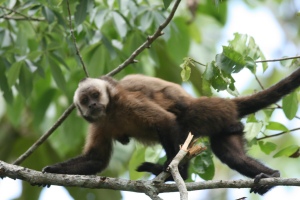Polyspecific associations are associations between species. As primates often live in areas lush, fertile, and viable forests- density of species is a natural result. However this closeness is emphasized when food resources are similar. This will result in species exploiting certain food areas. Regarding food, members of the same species, will bond together to get group access to a certain food source. In Primate Behavior Ecology, Strier gives us a loose diagram of all the factors that go into interspecies associations and it’s clear to see how many diverse and complex factors will play a role. Some of the factors include dietary diversity within species, population densities, distribution of food, predation pressure, and availability of potential partners, geography, presence or absence of competitors. Strier makes it very clear that polyspecific associations are the result of a myriad of circumstances and realities in the primate world.
An example exists in Manu Nation Park, Peru where squirrel monkeys associate with brown capuchin monkeys. Brown capuchins are larger than squirrel monkeys and can physically win out in a confrontation. Strier states that squirrel monkeys maintain the associations because capuchins have strong jaws that are able to open difficult nuts and fruits. Squirrel monkeys do not have this ability so their associate with capuchins effect their diets. The nuts and fruits that have been discarded by capuchins will likely be eaten by squirrel monkeys. This is an example of a polyspecific association that benefits one group and not the other.
(Squirrel Monkey top, Brown Capuchin on bottom)
Strier gives another example of a beneficial polyspecific association at the same location between saddle-back tamarins and mustached tamarins. These two species have formed a permanent association. These species forge together, defend the same range, habitat preferences, and eat a similar diet. Their diet is really what brings these two species together. Saddle-back tamarins remain on the group and mustached tamarins forage in the trees. Insects that are dropped by the mustached tamarins are often caught by the scavenging saddle back tamarins below. It has also been recorded that species will follow one another to food sources that are less known or more abundant. However, diets change with the season- so polyspecific associations often change with the seasons. I found primates motivated to form polyspecific associations due to food to be slightly more interesting then predator-prey associations because the way in which a primate accesses and maintains a food source fascinates me. The way primates will adapt their behavior, form alliances, and shrewdly create a system beneficial to themselves (like squirrel monkeys) is a sign of developed cognition and awareness.
References:
Strier, Karen B. Primate Behavioral Ecology. Boston: Allyn and Bacon, 2000. Print.
Pictures: http://commons.wikimedia.org/wiki/File:Cebus_apella_macrocephalus_(Brown_Capuchin_Monkey).jpg


